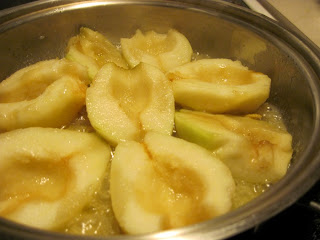I made sweet potato pie. I followed the recipe from
the first google hit for "sweet potato pie," with some alterations.
Is this worth writing about?
I made some very broad statements in
the last post, as I'm wont to do. While I was making the crust for the pie, I kept having to look back at the recipe I adapted from
Helen Rennie to remember quantities. Despite making pastry dough many times, I
needed that recipe. Or at least I needed its list of quantities. The recipe is not disposable. It's a kind of helper--somewhere to defer my memory. It's an instance of a cliche of how the internet has changed the nature of knowledge: it's not so important if one remembers everything, so long as one knows where to look. In the case of recipes however, the internet is not necessary at all--encyclopedic cookbooks have been serving as cyborg extensions of memory for a long time.
So I don't need to know how to make pastry dough. I wrote it here in this blog. The blog remembers how. To return to my question, is this worth writing, let's compare this to my diaries. I have boxes and boxes of diaries. Most of them I have read at least twice. Reading them is at once familiar and surprising--on the one hand, reading them triggers memories and I might also recall writing what I wrote, on the other, I had, up until reading it, forgotten much if not all of what I wrote. One is almost always remembering in one way or another, but there is obviously nothing cumulative about it. Reading a diary doesn't add to a collection of things I remember, but puts me in a different stream of remembering. Through reading the diary some memories come to life again--I think about them again briefly, they might crop up over and over for a long time. In other words, the diary must be read, and reading happens in time. Having "saved" (the anxiety of losing memories drove much of my diary writing) these memories in a diary, only in the unread text of the diary might they be saved. Only without a reader might the text be said to exist as a totality. But not really, of course--it isn't anything without being read, is it?
But this blog is not a diary. I'm not trying to record the ephemera of experience here. A recipe is simply supposed to record a procedure in a way that's followable. Actually this isn't so simple, as I've discussed
before. And thankfully. Wouldn't it be awfully dull if even just a recipe could be written in the universal register? This suggests another purpose for a recipe: to
not be quite followable. Not that a recipe writer has to try to do this, but a recipe's potential to confuse, mystify, or unintentionally inspire might be valued. Because apparently I need to subject recipes to the literary theories of decades ago.
The pie was good. The crust I thought was a bit too hard, although someone else liked it, called it "crunchy." I prebaked the crust for fifteen minutes or so before filling it, using the sweet potato pieces in tinfoil as a weight to keep the crust from puffing up. Improvising a weight was the most enjoyable part. Next time however I'll just fill the unbaked crust, so that the crust turns out softer.































